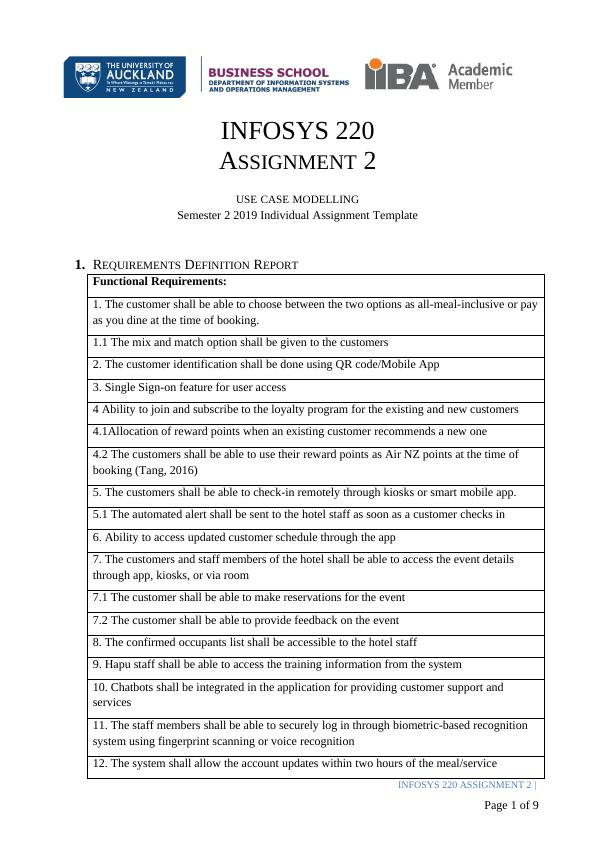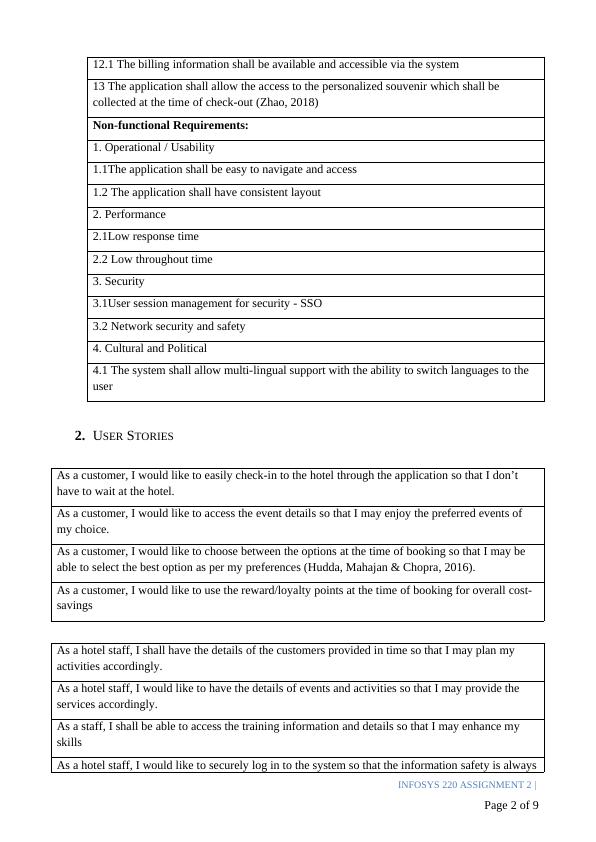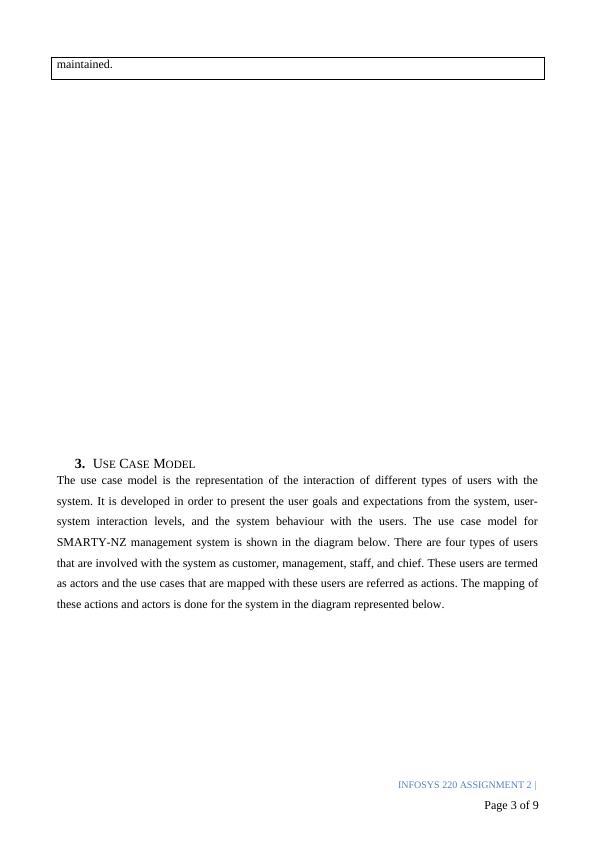Use Case Modelling for Semester 2 2019 Individual Assignment Template
Added on 2022-12-19
9 Pages1570 Words76 Views
INFOSYS 220
ASSIGNMENT 2
USE CASE MODELLING
Semester 2 2019 Individual Assignment Template
1. REQUIREMENTS DEFINITION REPORT
Functional Requirements:
1. The customer shall be able to choose between the two options as all-meal-inclusive or pay
as you dine at the time of booking.
1.1 The mix and match option shall be given to the customers
2. The customer identification shall be done using QR code/Mobile App
3. Single Sign-on feature for user access
4 Ability to join and subscribe to the loyalty program for the existing and new customers
4.1Allocation of reward points when an existing customer recommends a new one
4.2 The customers shall be able to use their reward points as Air NZ points at the time of
booking (Tang, 2016)
5. The customers shall be able to check-in remotely through kiosks or smart mobile app.
5.1 The automated alert shall be sent to the hotel staff as soon as a customer checks in
6. Ability to access updated customer schedule through the app
7. The customers and staff members of the hotel shall be able to access the event details
through app, kiosks, or via room
7.1 The customer shall be able to make reservations for the event
7.2 The customer shall be able to provide feedback on the event
8. The confirmed occupants list shall be accessible to the hotel staff
9. Hapu staff shall be able to access the training information from the system
10. Chatbots shall be integrated in the application for providing customer support and
services
11. The staff members shall be able to securely log in through biometric-based recognition
system using fingerprint scanning or voice recognition
12. The system shall allow the account updates within two hours of the meal/service
INFOSYS 220 ASSIGNMENT 2 |
Page 1 of 9
ASSIGNMENT 2
USE CASE MODELLING
Semester 2 2019 Individual Assignment Template
1. REQUIREMENTS DEFINITION REPORT
Functional Requirements:
1. The customer shall be able to choose between the two options as all-meal-inclusive or pay
as you dine at the time of booking.
1.1 The mix and match option shall be given to the customers
2. The customer identification shall be done using QR code/Mobile App
3. Single Sign-on feature for user access
4 Ability to join and subscribe to the loyalty program for the existing and new customers
4.1Allocation of reward points when an existing customer recommends a new one
4.2 The customers shall be able to use their reward points as Air NZ points at the time of
booking (Tang, 2016)
5. The customers shall be able to check-in remotely through kiosks or smart mobile app.
5.1 The automated alert shall be sent to the hotel staff as soon as a customer checks in
6. Ability to access updated customer schedule through the app
7. The customers and staff members of the hotel shall be able to access the event details
through app, kiosks, or via room
7.1 The customer shall be able to make reservations for the event
7.2 The customer shall be able to provide feedback on the event
8. The confirmed occupants list shall be accessible to the hotel staff
9. Hapu staff shall be able to access the training information from the system
10. Chatbots shall be integrated in the application for providing customer support and
services
11. The staff members shall be able to securely log in through biometric-based recognition
system using fingerprint scanning or voice recognition
12. The system shall allow the account updates within two hours of the meal/service
INFOSYS 220 ASSIGNMENT 2 |
Page 1 of 9

12.1 The billing information shall be available and accessible via the system
13 The application shall allow the access to the personalized souvenir which shall be
collected at the time of check-out (Zhao, 2018)
Non-functional Requirements:
1. Operational / Usability
1.1The application shall be easy to navigate and access
1.2 The application shall have consistent layout
2. Performance
2.1Low response time
2.2 Low throughout time
3. Security
3.1User session management for security - SSO
3.2 Network security and safety
4. Cultural and Political
4.1 The system shall allow multi-lingual support with the ability to switch languages to the
user
2. USER STORIES
As a customer, I would like to easily check-in to the hotel through the application so that I don’t
have to wait at the hotel.
As a customer, I would like to access the event details so that I may enjoy the preferred events of
my choice.
As a customer, I would like to choose between the options at the time of booking so that I may be
able to select the best option as per my preferences (Hudda, Mahajan & Chopra, 2016).
As a customer, I would like to use the reward/loyalty points at the time of booking for overall cost-
savings
As a hotel staff, I shall have the details of the customers provided in time so that I may plan my
activities accordingly.
As a hotel staff, I would like to have the details of events and activities so that I may provide the
services accordingly.
As a staff, I shall be able to access the training information and details so that I may enhance my
skills
As a hotel staff, I would like to securely log in to the system so that the information safety is always
INFOSYS 220 ASSIGNMENT 2 |
Page 2 of 9
13 The application shall allow the access to the personalized souvenir which shall be
collected at the time of check-out (Zhao, 2018)
Non-functional Requirements:
1. Operational / Usability
1.1The application shall be easy to navigate and access
1.2 The application shall have consistent layout
2. Performance
2.1Low response time
2.2 Low throughout time
3. Security
3.1User session management for security - SSO
3.2 Network security and safety
4. Cultural and Political
4.1 The system shall allow multi-lingual support with the ability to switch languages to the
user
2. USER STORIES
As a customer, I would like to easily check-in to the hotel through the application so that I don’t
have to wait at the hotel.
As a customer, I would like to access the event details so that I may enjoy the preferred events of
my choice.
As a customer, I would like to choose between the options at the time of booking so that I may be
able to select the best option as per my preferences (Hudda, Mahajan & Chopra, 2016).
As a customer, I would like to use the reward/loyalty points at the time of booking for overall cost-
savings
As a hotel staff, I shall have the details of the customers provided in time so that I may plan my
activities accordingly.
As a hotel staff, I would like to have the details of events and activities so that I may provide the
services accordingly.
As a staff, I shall be able to access the training information and details so that I may enhance my
skills
As a hotel staff, I would like to securely log in to the system so that the information safety is always
INFOSYS 220 ASSIGNMENT 2 |
Page 2 of 9

maintained.
3. USE CASE MODEL
The use case model is the representation of the interaction of different types of users with the
system. It is developed in order to present the user goals and expectations from the system, user-
system interaction levels, and the system behaviour with the users. The use case model for
SMARTY-NZ management system is shown in the diagram below. There are four types of users
that are involved with the system as customer, management, staff, and chief. These users are termed
as actors and the use cases that are mapped with these users are referred as actions. The mapping of
these actions and actors is done for the system in the diagram represented below.
INFOSYS 220 ASSIGNMENT 2 |
Page 3 of 9
3. USE CASE MODEL
The use case model is the representation of the interaction of different types of users with the
system. It is developed in order to present the user goals and expectations from the system, user-
system interaction levels, and the system behaviour with the users. The use case model for
SMARTY-NZ management system is shown in the diagram below. There are four types of users
that are involved with the system as customer, management, staff, and chief. These users are termed
as actors and the use cases that are mapped with these users are referred as actions. The mapping of
these actions and actors is done for the system in the diagram represented below.
INFOSYS 220 ASSIGNMENT 2 |
Page 3 of 9

End of preview
Want to access all the pages? Upload your documents or become a member.
Related Documents
Use Case Modelling for Deskliblg...
|8
|953
|91
CCS Delivery Person, Manager, and User Storieslg...
|11
|948
|60
System Analysis and Designlg...
|13
|2182
|65
App Development (Crunchy Salad)lg...
|9
|2756
|20
The Gamification in the Applications | Essaylg...
|6
|1353
|455
Virtual Reality of Hotel Booking Platformlg...
|8
|2268
|12
